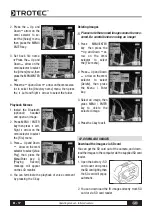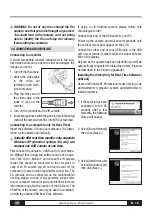
B -
3
Operating manual – Infrared camera
- Do not place the batteries near a heat source or ex-
pose them to direct flame or heat.
Neither should you immerse them in water. Such
exposure may damage the batteries and lead to the
leakage of corrosive liquids, fire, electrical shock,
explosion or serious injury.
- Do not attempt to disassemble, alter or apply heat to
the batteries.
There is a serious risk of injury due to explosion.
Immediately flush with water any area of the body,
including the eyes and mouth, or clothing, that comes
into contact with the inner contents of a battery.
In case of contact of the eyes or mouth with these
substances, immediately flush with water and seek
medical assistance.
- Avoid dropping or subjecting the batteries to severe
impacts that could damage the casings.
It could lead to leakage and injury.
- Do not short-circuit the battery terminals with metallic
objects, such as key holders.
It could lead to overheat-
ing, burns and other injuries.
- Before you discard a battery, cover the terminal with
tape or other insulators to prevent direct contact
with other objects.
Contact with the metallic components of other materials
in waste containers may lead to fire or explosions. Dis-
card the batteries in specialized waste facilities if
available in your area.
- Use only recommended batteries and accessories.
Use of batteries not expressly recommended for this
equipment may cause explosions or leaks, resulting
in fire, injury and damage to the surroundings.
- Disconnect the compact power adapter from both
the IR camera and power outlet after recharging
and when the IR camera is not in use to avoid fires
and other hazards.
Continuous use over a long period
of time may cause the unit to overheat and distort,
resulting in fire.
- Do not use the battery charger or compact power
adapter if the cable or plug is damaged, or if the plug
is not fully inserted into the power outlet.
The battery charger varies according to your region.
- Exercise due caution when screwing on the separately
sold tele-lens, close-up lens.
If you loosen, fall off and shatter, the glass shards
may cause an injury.
- If your camera is used for an extended period, the IR
camera body may become warm.
Please take care when operating the IR camera for an
extended period as your hands may experience a bur-
ning sensation.
Prevent Malfunction
Read on to learn about preventing malfunction of IR
camera.
- Avoid damaging the detector of the IR camera
- Avoid condensation related problems
Moving the IR camera rapidly between hot and cold
temperatures may cause condensation (water drop-
lets) to form on its external and internal surfaces.
You can avoid this by placing the IR camera in the
plastic case (bundle) and letting it adjust to tempe-
rature changes slowly before removing it from the
case.
- If condensation forms inside the IR camera.
Stop using the camera immediately if you detect conden-
sation. Continued use may damage the IR camera.
Remove the PC card, and battery or a household power
source, from the IR camera and wait until moisture
evaporates completely before resuming use.
- Extended storage
When not using the IR camera for extended periods of
time, remove the battery from the IR camera or battery
charger and store the IR camera in a safe place. Storing
the IR camera for extended periods with battery in
place will run down the battery.





































